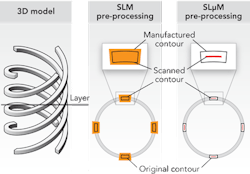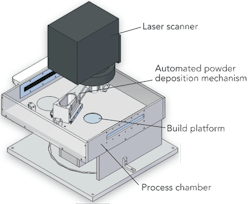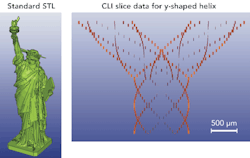SLµM: Additive manufacturing in micro scale
Requires special pre-processing to achieve high-quality surfaces
Matthias Gieseke, Christian Noelke, and Stefan Kaierle
Additive manufacturing (AM) of micro parts is gaining great interest now that a lot of industrial metals like titanium and aluminum are established AM processes. The next challenge is increasing the resolution within these processes in the production of micro-sized parts to achieve good surface quality to minimize post-processing. Many remarkable results regarding the production of micro parts have been published. For example, parts with a resolution of 35 µm were made from tungsten using laser micro sintering [1].
Laser Zentrum Hannover e.V. has been working in the field of AM [2] since 1992, focusing on micro manufacturing and establishing processes on special materials. Machine systems for laser metal deposition as well as selective laser melting (SLM) have been built up within several research projects.
Manufacturing at micro size using SLM makes special demands on the process. Selective laser micro melting (SLµM) is characterized by the fact that the manufacturing process takes place at the limits of the machine’s resolution capability. This attaches great importance to every processed line that is used to build a complex part. To achieve a resolution below 30 µm, parts are built up out of single open lines instead of closed and filled contours (see FIGURE 1). Thus, the creation of slice data is more complex since no commercial software tools are available yet. Beyond this, self-made slice data are partially difficult to process in a commercially available SLM machine system.
In addition, SLµM means having a laser spot and a part resolution < 100 µm and using powders < 50 µm. Due to the use of fine particle sizes, the powder material tends to agglomerate, and special powder deposition systems are required.
Experiments
A laboratory machine system was developed to manufacture micro parts within the SLM process. The SLM test setup was built as a modular machine system with the ability to change laser optics, scanning system, laser source, and powder deposition mechanisms (see FIGURE 2). To enable SLµM, the setup is equipped with a 50 W fiber laser and a 100 mm telecentric f-theta lens aiming in a laser spot diameter of 19.4 µm. The scanning system for beam manipulation is controlled by the commercial software tool SAM 3D (Scaps GmbH, Germany), which communicates with the self-made machine control software via TCP/IP [developed with LabView (National Instruments, USA)]. SAM 3D is able to import 3D models in the STL format, as well as slice data in the CLI format in ASCII or binary syntax. The CLI data written in ASCII are of great importance for micro processing since every layer can be coded by the user using an easy-to-learn syntax.
The machine control software allows an easy and quick implementation of new process hardware and new program sequences. The shown SLM test setup is integrated into a surrounding glovebox, using argon to produce a protective gas atmosphere within the process zone at an oxygen level below 300 ppm.
To validate the ability of manufacturing complex-shaped 3D parts within this process, standard STL files and CLI-slice data for SLµM were used. As a test structure, a CLI-slice data set for a y-shaped helix, consisting of several twisted struts and having a length of 50 µm, was written in ASCII format (see FIGURE 3).
Results
Selective laser micro melting requires an adequate setup of the process parameters because any process errors are more severe than in macro processes since the structures are comparably small. Often, the consequences of these errors are visible a long time after their appearance. A local increase of the build-up rate in the range of a few microns, e.g., due to too much energy input, leads to structures sticking out of the powder bed. These structures can be destroyed by the coating mechanism and consequently damage the whole part.
By varying the scan speed, several y-shaped helix structures were manufactured. A minimum strut diameter of 60 µm could be reached, though a partial strut breakage occurred. To avoid these defects, higher-energy inputs are used that lead to final strut diameters of 90 µm (see FIGURE 4).
The Statue of Liberty, the Eiffel Tower, and other objects with a height of 8 mm were built using a standard STL file (see FIGURE 5). Most of the scaffold of the Eiffel Tower could be produced in detail and is visible on the object. The resolution of small neighboring structures like single struts of the scaffold depends on the scan strategy. After the exposition of a single strut, the heat needs time to dissipate in order to prevent powder adhesion and broadening the single track. This can be accomplished by random scanning of the struts with an adequate distance between them or by setting delays between the different exposition processes.
Compared to conventionally manufactured SLM parts, SLµM can achieve high quality surfaces (Ra = 8 µm). However, in comparison to the minimum structure dimensions that can be achieved, the resulting surface roughness is comparably high, with adhering particles at the outer shape. These molten particles have an additional impact on the parts’ accuracy. To establish a simple post-treatment method test series on electro-polishing were undertaken. Using sulfuric acid and phosphoric acid (1:1) as electrolyte, several tests were carried out. Independent of the structure, electro-polishing processes can be a successful method to flatten the surfaces of SLµM parts (see FIGURE 6).
Conclusion and outlook
Selective laser micro melting is a method to create micro parts, but requires a special pre-processing for the 3D data. To get an adequate SLµM slice data set, a CLI file can be written manually by the user. Using SLµM, a resolution below 30 µm can be reached. The parts have a surface roughness of Ra = 8 µm that can be post-treated using mechanical or electro-polishing to flatten the parts’ surfaces. This also has an impact on the mechanical properties.
Generally, electro-polishing is an easy and fast way to flatten the surface of micro parts in a post-treatment. However, the polishing parameters have to be set up for every part accurately since the removal strongly depends on the geometry. Thus, this method is more useful for similar parts or families of similar-looking parts like tooth implants.
For manufacturing 3D parts out of STL data sets, the scan strategy is of great importance. Scanning of small neighboring structures requires a delay time between the laser expositions to increase the heat dissipation. Otherwise, powder particles can adhere, and tracks get broader due to the high-energy input.
Regarding a further increase of the resolution within the SLM process, the major limitation is the powder. The smaller the powder particles, the more they tend to agglomerate and therefore impede the coating. The limitations of achieving an adequate coating depend not only on the particle diameter but also on the morphology and the material properties of the powder. Scaling down the laser spot size is a minor problem since impeding nonlinear effects are not occurring at the current spot diameters.
Manufacturing sophisticated high-resolution micro parts for medical applications is one of the future challenges in additive manufacturing. Using nickel-titanium-shape memory alloys offers the possibility to manufacture "intelligent" micro actuators to adapt implants to the surrounding tissue. Also, biodegradable magnesium alloys are of great interest to manufacture self-degrading implants like stents. Both materials are challenging to use in AM processes, especially to enable high resolution using adhering fine-grained powders.
Acknowledgments
The Federal Ministry of Education and Research (BMBF) of the Federal Republic of Germany supports REMEDIS as part of its "Leading-Edge Research and Innovation in the New German Länder" programme (Project number FKZ: 03IS2081).
References
1. P. Regenfuss, R. Ebert, and H. Exner, „Laser micro sintering: A versatile instrument for the generation of microparts," Laser Technik Journal, 26-31, 2007.
2. N.N.: LZH Jahrbuch 1992, Laser Zentrum Hannover e.V.,1992, Germany.
3. M. Gieseke, V. Senz, M. Vehse, S. Fiedler, R. Irsig, M. Hustedt, K. Sternberg, C. Nölke, S. Kaierle, V. Wesling, J. Tiggesbäumker, K.-H. Meiwes-Broer, H. Seitz, K.-P. Schmitz, and H. Haferkamp, "Additive manufacturing of drug delivery systems," 46th Annual Conference of the German Society for Biomedical Engineering (BMT 2012), 425-442, 2012
4. E. Dahl, "Mechanische Prüfung von lasergeschmolzenen Mikrobauteilen," Bachelor Thesis, University for Applied Science and Arts, Hannover, Germany, 2013
Matthias Gieseke, Christian Noelke([email protected]), and Stefan Kaierle work at the Materials and Processes Department of Laser Zentrum Hannover e.V., Hollerithallee 8, 30419, Hannover, Germany.
More Industrial Laser Solutions Current Issue Articles
More Industrial Laser Solutions Archives Issue Articles






